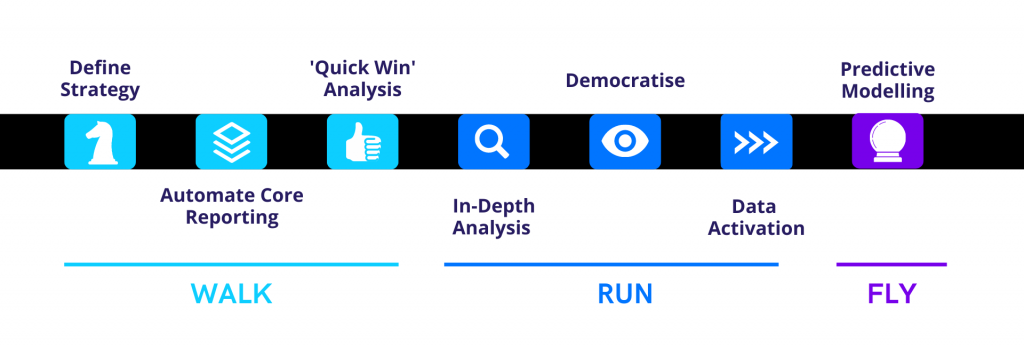Where Are You On Your Data Journey?
In today’s data-driven world, understanding your company’s data maturity has become more crucial than ever. Data has transformed from a mere byproduct of operations to a valuable asset that holds the key to unlocking business success.
Every company is on a journey with their analytics, and it can sometimes be difficult to understand which stage you are at, what your priorities should be and where to go next. As such we’ve broken down the level of data maturity in an organisation into three key stages: Walk, Run and Fly.

The Walk Stage
The first stage, WALK, sets the groundwork for effective data use:
1. Define Strategy: Before diving into data, it is crucial to align the organisation’s strategic goals with its data initiatives. This entails identifying business priorities and formulating questions that can be answered through data analysis. By clearly defining the objectives, you can focus their efforts on extracting the most valuable insights.
2. Automate Core Reporting: In this step, businesses need to choose the right tools and infrastructure to automate the collection, processing, and reporting of essential data. By leveraging a suitable data stack, you can ensure that the uniqueness of your business is replicated in your data.
3. ‘Quick Win’ Analysis: To build initial momentum and demonstrate the value of data analysis, organisations should identify top-level daily reports that can provide immediate insights. By focusing on easily attainable wins, businesses can showcase the potential benefits of data-driven decision-making to stakeholders.
The Run Stage
Once the foundation is in place, businesses can move on to the RUN stage, where they delve deeper into data analysis and leverage insights to drive decision-making. This stage involves the following key elements:
1. In-Depth Analysis: At this stage, businesses can explore more complex analyses that provide deeper insights into critical areas such as cost of acquisition, dynamic segmentation, user retention, marketing attribution, and more. By conducting thorough and sophisticated analyses, organisations can uncover patterns and trends that inform strategic decisions.
2. Data Democratisation: To maximise the value of data, it is essential to democratise its access and utilisation across the organisation. This involves fostering a data-driven culture by promoting tool adoption and training, appointing data champions to advocate for data-driven practices, and integrating data into decision-making processes at all levels. Furthermore, broadcasting data wins and success stories can inspire wider adoption and engagement.
3. Data Activation: Data activation involves using Reverse ETL (Extract, Transform, Load) tools to send modelled data back to the tools and platforms that teams actually use.
The Fly Stage
In the FLY stage, organisations leverage predictive modelling and AI to gain a competitive edge.
1. Predictive Modelling: By employing advanced techniques such as propensity modelling and natural language processing (NLP) models, organisations can make accurate predictions about future customer behaviour. For example you might have one model that shows you which customer section is at risk of churning and then another to show you which communication method is the most likely to work. Predictive models enable businesses to anticipate trends and personalise experiences.
2. Consider the Impact: It is crucial to assess where a data science model can have the most significant impact within the organisation. Consider not only the business problem, but the decisions that your team can actually make to see which model would have the most improvement.
3. Build into Automated Processes: For scenarios where the benefits of data analysis are clear-cut and repetitive, integrating Data Science models into automated processes can be highly beneficial. Enhance efficiency, reduce human error, and ensure consistent outcomes.
While the Fly stage can be very interesting and it’s easy to get excited about more advanced analytics, but don’t overlook the walk and run stages. There is a lot of high ROI data projects here. Plan your data roadmap iteratively and aim to extract value at every step.
In Conclusion
Creating value from data requires a systematic approach that progresses through the WALK, RUN, and FLY stages and there’s a lot of value that can be extracted throughout that process. If you are looking to take the next step in your analytics journey, why not get in touch with the friendly 173tech team!


